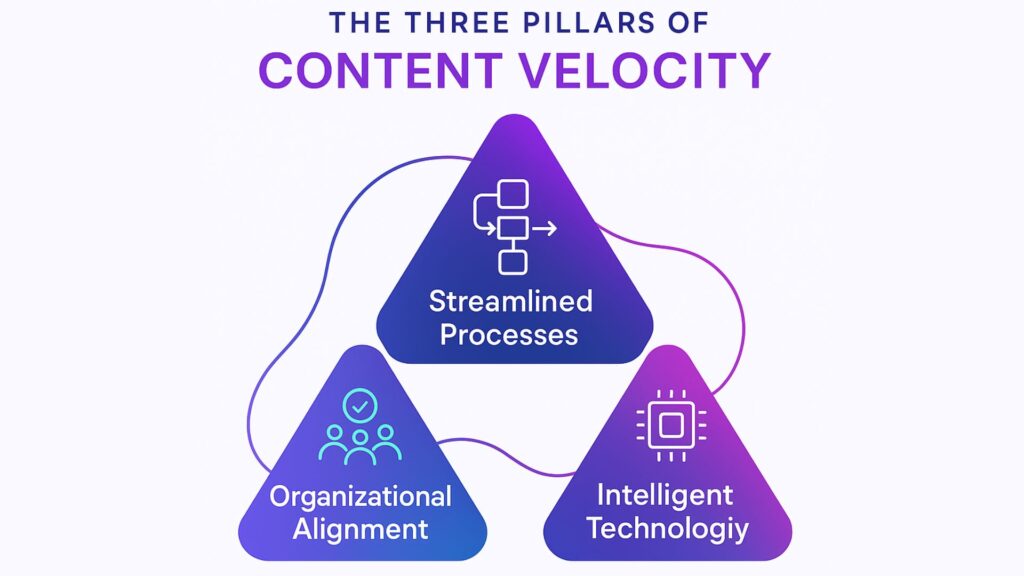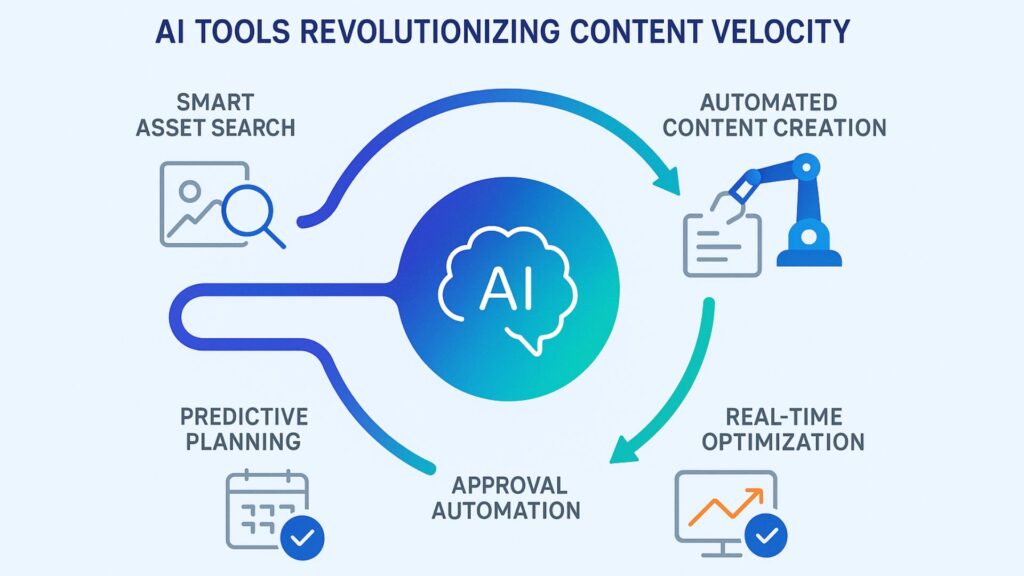Content velocity measures how quickly organizations create and distribute marketing content to meet audience demands.
- Modern businesses need faster content production to stay competitive.
- Enterprise content bottlenecks cost companies millions annually in lost productivity.
- AI-powered platforms can accelerate content creation while maintaining brand guidelines.
- Strategic content velocity drives higher marketing ROI than ad-hoc approaches.
The future belongs to organizations that balance speed with quality through intelligent automation.
Picture this: It’s Monday morning, and your marketing team already has three urgent content requests piling up. There’s a product launch campaign due next week, sales collateral that needs updating for a major prospect, and social media assets for an industry event that’s literally tomorrow.
Welcome to the reality of modern marketing, where content demand has exploded but timelines have shrunk. Most marketers actively invest in content marketing, yet many struggle to produce content fast enough to meet business needs. However, over 60% of leaders believe that AI could be the answer to filling efficiency roles while humans focus on the creative side of marketing.
What is content velocity, and how can it become your competitive advantage? Unlike traditional approaches that treat content creation as a linear process, intelligent content operations transform how organizations plan, create, and distribute digital assets at scale.
What Is Content Velocity: The Complete Definition
Content velocity is a strategic measure of how efficiently your organization moves content from initial concept to active deployment across all channels.
Here’s a helpful way to think about it: Content velocity is basically the marketing version of how fast a factory can make widgets. Factories track how many quality products roll off the line per hour, right? Marketing teams need that same level of insight into their content production capacity.
Content Velocity vs. Content Volume: The Key Difference
Many organizations confuse content velocity with content volume, but they’re fundamentally different metrics. Content volume simply counts how much you produce, such as 50 blog posts per month, 200 social media updates, and 15 video assets. Content velocity measures the speed and efficiency of your entire content lifecycle, from ideation to performance analysis.
A team producing 10 high-quality, strategically aligned pieces of content per month with streamlined workflows demonstrates higher content velocity than a team churning out 50 generic pieces that require multiple revisions and approvals.
Why Content Speed Matters More Than Ever
Trends emerge and fade within days. Customer expectations shift rapidly. Competitive advantages disappear quickly if you can’t adapt your messaging and creative assets fast enough.
High-performing marketing teams are 2.5x more likely to use AI and automation to increase content speed. They understand that being first to market with relevant, engaging content often matters more than being perfect.
The Three Pillars of Content Velocity
Effective content velocity rests on three foundational elements.
- Streamlined processes that eliminate unnecessary steps and bottlenecks.
- Intelligent technology that automates repetitive tasks and enhances human creativity.
- Organizational alignment that ensures everyone understands priorities and can make decisions quickly.

When these three pillars work in harmony, organizations achieve a sustainable balance between speed, quality, and strategic focus, unlocking what is true content velocity.
What Slows Down Enterprise Content Production?
Here’s the frustrating part: You’d think bigger companies with massive budgets and specialized teams would crush it when it comes to content speed. But that’s rarely the case. In fact, enterprise organizations often move slower than their scrappier, smaller competitors. Understanding these bottlenecks is vital for any organization looking to improve its content throughput.
The Hidden Content Bottlenecks Killing Your ROI
Enterprise content production faces unique challenges that smaller teams never encounter. Larger organizations are up against multiple stakeholders with competing priorities, complex approval chains that add days or weeks to simple projects, and siloed systems where assets get lost in email threads or forgotten in shared drives.
Inefficient content processes cost large organizations an average of $2.5 million annually through wasted time, missed opportunities, and duplicated efforts. These costs compound as teams grow larger and content demands increase.

The most common bottlenecks include inconsistent brand guidelines that require extensive revisions, outdated content management systems that make collaboration difficult, and a lack of centralized asset libraries that force teams to recreate existing materials.
Approval Workflows That Create Content Gridlock
Let’s be honest: Most approval processes were built for a world where campaigns launched once a quarter and messaging could stay put for months. But we’re not living in that world anymore. Real-time marketing means your approval workflows need to keep up or get out of the way.
Many enterprise teams still rely on linear approval chains where content moves sequentially through legal, brand, compliance, and executive review. Each stop adds time, often with feedback that conflicts with earlier approvals. By the time content clears all checkpoints, the original strategic rationale may no longer apply.
Asset Management Chaos and Search Failures
Sound familiar? You need a product image for an urgent campaign, and you know the perfect photo exists somewhere. You saw it in a presentation just last month. But now? You’re stuck searching through three different platforms, digging through shared drives, and Slacking colleagues with “Hey, do you remember where that photo is?
This asset discovery challenge multiplies across enterprise organizations. Teams waste their content creation time simply looking for existing materials they could repurpose or reference.
How Does Content Speed Drive Content Marketing ROI?
Content velocity directly impacts your marketing return on investment through multiple channels. Faster content production means you can capitalize on trends, respond to competitors, and support sales teams with timely materials.
The ROI Formula: Velocity × Quality × Distribution
Content marketing ROI reflects your organization’s ability to consistently produce relevant, engaging content that supports business objectives across all touchpoints.
The best content teams have figured out how to move fast without cutting corners on quality or distribution. They know that cranking out mediocre content at lightning speed doesn’t help anyone. But neither does creating a masterpiece that hits the market three months too late. Companies that have their content operations dialed in see better marketing ROI than those still winging it with ad-hoc processes.
Measuring Content Throughput That Actually Matters
Traditional content metrics focus on output volume and engagement rates. While these metrics matter, content velocity measurement requires additional indicators that reflect operational efficiency and strategic alignment.
Key content velocity metrics include time from brief to publication, revision cycles per asset, asset reuse rates across campaigns, and speed of content personalization for different audience segments. These operational metrics predict long-term content marketing success more accurately than engagement metrics alone.
From Content Speed to Revenue: Real Business Impact
Content velocity improvements translate directly into business outcomes. Faster campaign launches mean you can capture seasonal opportunities and respond to competitive threats. Reduced content production costs free up budget for media spend and strategic initiatives. Improved asset reuse rates increase the lifetime value of your content investments.
Organizations with high content velocity report several competitive advantages. They can support more aggressive growth strategies because their content operations scale effectively. They adapt faster to market changes because they’re not locked into slow production cycles. They achieve better marketing-sales alignment because they can provide timely, relevant materials that support deal progression.
How Are AI Tools Revolutionizing Content Velocity?
AI is shaking up the entire content lifecycle, from that first brainstorm all the way through to performance tracking. The best part? These tools handle the boring, repetitive stuff so your team can focus on the creative work that actually requires human brainpower.

1. Intelligent Asset Management: Auto-Tagging and Smart Search
Modern digital asset management platforms use computer vision and natural language processing to automatically categorize and tag content as it’s uploaded. Instead of relying on manual metadata entry, AI analyzes image content, extracts text from documents, and suggests relevant keywords based on visual elements and context.
Automation dramatically improves content discoverability. Marketing teams can find the assets they need using natural language searches rather than remembering specific file names or folder structures.
2. Automated Content Creation: Template Generation and Variants
AI-powered content creation tools can generate multiple variations of core messages, adapt content for different channels, and create personalized versions at scale. These systems learn your brand voice and style guidelines to ensure consistency across all outputs.
For enterprise teams managing multiple brands or regional markets, automated content variation can reduce production time while maintaining quality standards.
3. Predictive Content Planning: AI-Powered Editorial Calendars
Advanced content operations platforms analyze historical performance data, seasonal trends, and competitive intelligence to recommend optimal content types and timing. This predictive capability helps teams prioritize content while avoiding oversaturated topics.
4. Smart Approval Workflows: Reducing Review Cycles
AI can streamline approval processes by automatically checking content against brand guidelines, compliance requirements, and legal constraints. This pre-screening reduces manual review time and catches potential issues before human reviewers get involved.
5. Real-Time Performance Optimization: Content That Adapts
The most sophisticated content operations platforms continuously monitor asset performance and automatically suggest optimizations. AI can recommend different images for underperforming campaigns or identify content gaps based on audience engagement patterns.
How Do You Build Your Content Velocity Strategy?
Improving content velocity requires strategic planning and tactical execution. Start by understanding your current state, then address the biggest bottlenecks affecting your team’s efficiency.
Audit Your Current Content Throughput
Start by taking a good, hard look at how your content process actually works today. Time how long it takes to move different types of content from “Hey, we need this” to “It’s live.” Pay attention to where things get stuck and which steps eat up time without adding real value.
This audit should include both quantitative metrics (average production times, revision cycles, asset reuse rates) and qualitative feedback from team members about pain points and inefficiencies.
Identify and Eliminate Speed Bottlenecks
Once you understand your current state, prioritize improvements based on impact and feasibility. Quick wins include standardizing approval processes, creating content templates, or implementing project management tools that improve collaboration.
Long-term improvements involve upgrading content management systems, restructuring team responsibilities, or investing in automation technologies that handle routine tasks.
Choose the Right Content Automation Tools
Choose technology that actually solves your specific problems. Don’t fall into the trap of thinking the shiniest new AI platform will magically fix everything if your basic processes are still a mess. Fix the foundation first, then add the fancy tools.
Start with tools that address your most significant pain points, then gradually expand your technology stack as you build organizational capabilities and see measurable improvements.
FAQ
What’s the ideal content velocity for B2B companies? Content velocity varies based on industry, company size, and target audience. Most successful B2B organizations aim to produce a few pieces of high-quality content per week across all channels, with the ability to create urgent content within 24-48 hours when needed.
How do you measure content speed without sacrificing quality? Focus on process metrics like time from brief to first draft, revision cycles per asset, and approval turnaround times. Set quality standards upfront and track adherence rates. The goal is consistent quality delivered faster, not rushed work that requires extensive revisions.
Can small teams compete with enterprise content velocity? Absolutely. Small teams often have advantages, including faster decision-making, fewer approval layers, and greater agility. By leveraging AI-powered tools and streamlined processes, small teams can often achieve higher effective content velocity than larger organizations with more complex workflows.
What role does content repurposing play in velocity? Content repurposing is crucial for velocity because it maximizes the value of each content investment. A single well-researched piece can become blog posts, social media content, video scripts, email campaigns, and sales materials. Organizations with strong repurposing strategies can achieve higher content output from the same creative resources.
Ready to Accelerate Your Content Velocity?
Content velocity enables organizations to respond quickly to opportunities, support aggressive growth plans, and maintain competitive advantages in rapidly changing markets.Smart marketing leaders are turning to Aprimo to power intelligent content operations that accelerate velocity without sacrificing quality. With AI-driven automation that eliminates repetitive tasks and advanced workflows that keep teams aligned, we help brands move faster and scale smarter. Book a demo today.


